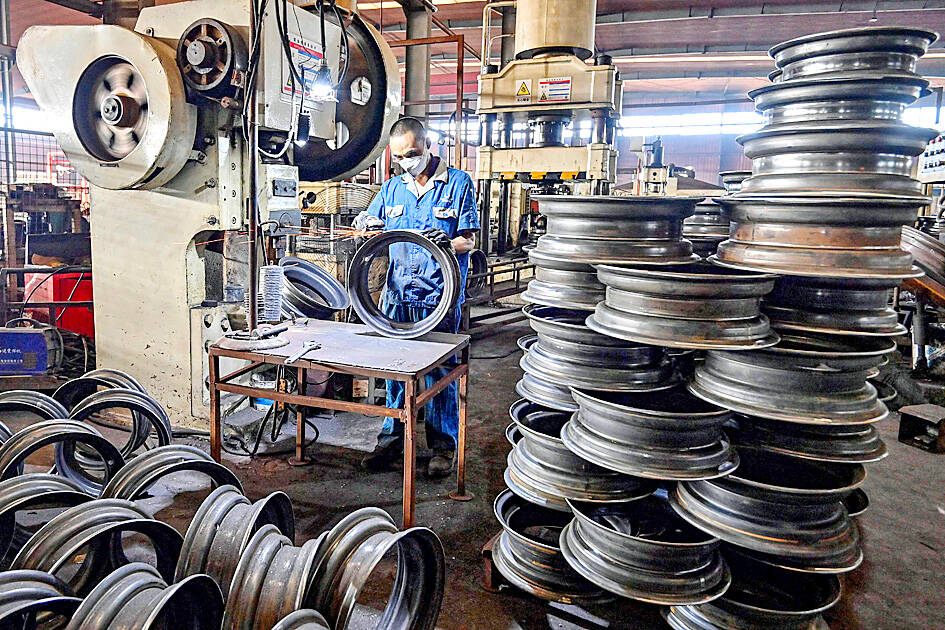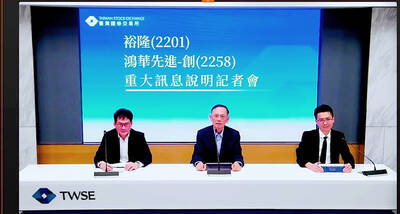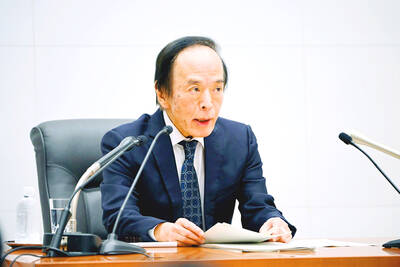Profits at China’s industrial firms fell at the sharpest pace since April last year, dragged down by weaker manufacturing as part of an economic slowdown that is now prompting extraordinary stimulus efforts.
Industrial profits at large Chinese companies decreased 17.8 percent on an annual basis last month, after a 4.1 percent gain in July, the Chinese National Bureau of Statistics (NBS) said in a statement yesterday.
Earnings growth grew 0.5 percent to 4.65 trillion yuan (US$663 billion) in the first eight months compared with the same period last year.

Photo:AFP
Bloomberg Economics had forecast a deceleration to 3.6 percent last month, but expected growth to stay steady in the January-to-August period relative to the first seven months of the year. The figures are a key gauge of measuring the financial health of factories, mines and utilities that can affect their investment decisions in the months to come.
The NBS blamed last month’s slowdown — the first drop in five months — on a lack of market demand, the effect of high temperature and floods in some areas, as well as a high base of comparison.
“Domestic consumer demand is still weak, the external environment is complex and changeable, and the foundation for the recovery of industrial profit still needs to continue to consolidate,” NBS statistician Yu Weining (于衛寧) said in a statement accompanying the release.
The latest reading came against the backdrop of a slower-than-expected increase in industrial output last month, when it extended a weakening streak to the longest in almost three years.
The slowdown became more apparent during a weak earnings season that showed little sign of any imminent recovery in consumption.
Thinner profit margins reflect the frailty of the broader Chinese economy in the absence of stronger domestic demand. Underscoring the drag on earnings, producer prices have been falling since late 2022, intensifying fears that deflation was becoming entrenched in China.
With signs mounting that the world’s second-largest economy risked missing Beijing’s goal of growing about 5 percent, the government pivoted this week and unveiled a broad package of stimulus measures to revive growth.
The country’s top leadership also used its monthly huddle to call for stronger fiscal support and other steps that signaled a growing urgency to arrest the slowdown.

Taiwan Semiconductor Manufacturing Co (TSMC, 台積電) last week recorded an increase in the number of shareholders to the highest in almost eight months, despite its share price falling 3.38 percent from the previous week, Taiwan Stock Exchange data released on Saturday showed. As of Friday, TSMC had 1.88 million shareholders, the most since the week of April 25 and an increase of 31,870 from the previous week, the data showed. The number of shareholders jumped despite a drop of NT$50 (US$1.59), or 3.38 percent, in TSMC’s share price from a week earlier to NT$1,430, as investors took profits from their earlier gains

In a high-security Shenzhen laboratory, Chinese scientists have built what Washington has spent years trying to prevent: a prototype of a machine capable of producing the cutting-edge semiconductor chips that power artificial intelligence (AI), smartphones and weapons central to Western military dominance, Reuters has learned. Completed early this year and undergoing testing, the prototype fills nearly an entire factory floor. It was built by a team of former engineers from Dutch semiconductor giant ASML who reverse-engineered the company’s extreme ultraviolet lithography (EUV) machines, according to two people with knowledge of the project. EUV machines sit at the heart of a technological Cold

TAIWAN VALUE CHAIN: Foxtron is to fully own Luxgen following the transaction and it plans to launch a new electric model, the Foxtron Bria, in Taiwan next year Yulon Motor Co (裕隆汽車) yesterday said that its board of directors approved the disposal of its electric vehicle (EV) unit, Luxgen Motor Co (納智捷汽車), to Foxtron Vehicle Technologies Co (鴻華先進) for NT$787.6 million (US$24.98 million). Foxtron, a half-half joint venture between Yulon affiliate Hua-Chuang Automobile Information Technical Center Co (華創車電) and Hon Hai Precision Industry Co (鴻海精密), expects to wrap up the deal in the first quarter of next year. Foxtron would fully own Luxgen following the transaction, including five car distributing companies, outlets and all employees. The deal is subject to the approval of the Fair Trade Commission, Foxtron said. “Foxtron will be

INFLATION CONSIDERATION: The BOJ governor said that it would ‘keep making appropriate decisions’ and would adjust depending on the economy and prices The Bank of Japan (BOJ) yesterday raised its benchmark interest rate to the highest in 30 years and said more increases are in the pipeline if conditions allow, in a sign of growing conviction that it can attain the stable inflation target it has pursued for more than a decade. Bank of Japan Governor Kazuo Ueda’s policy board increased the rate by 0.2 percentage points to 0.75 percent, in a unanimous decision, the bank said in a statement. The central bank cited the rising likelihood of its economic outlook being realized. The rate change was expected by all 50 economists surveyed by Bloomberg. The